For me there is no right or wrong when it comes to cooking. It is not about following rules, it is about getting the results you want. Why insist on following a rule, if you can’t taste the difference anyway? Some methods are heavily debated. If I am unsure what method is best or if it is worth the additional effort, I will do experiments to find out if I can taste or measure the difference, with a detailed report on this blog. You can also watch my video about this topic on YouTube, which I made for the 2024 Sous Vide Summit by the International Sous Vide Association.
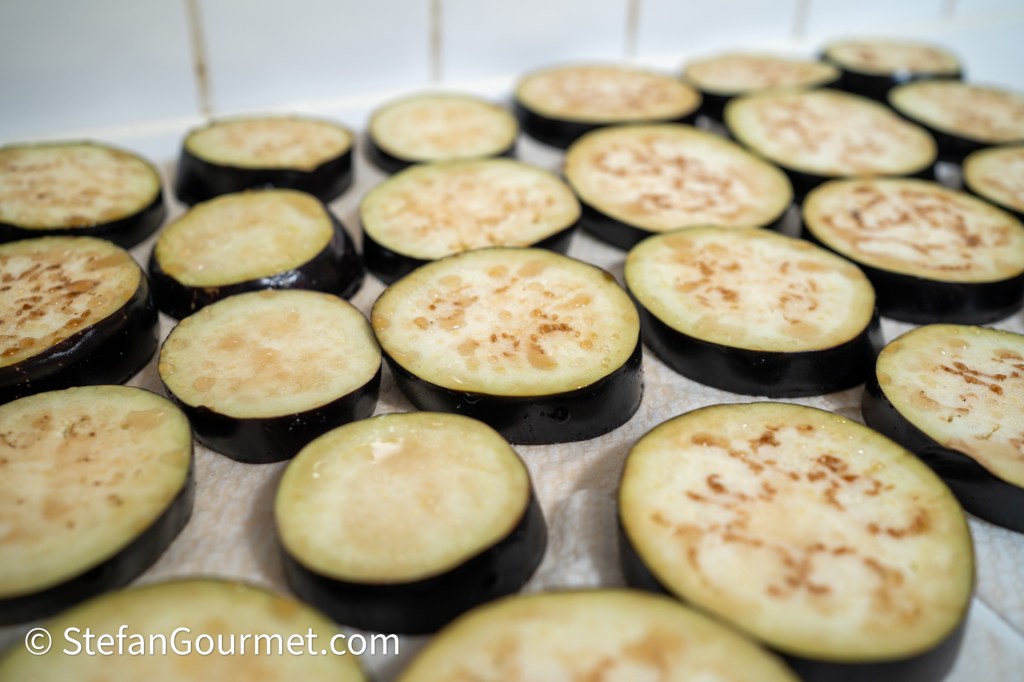
A topic that I’ve seen a lot of debates about is salting before or after sous vide. We all know that if you put salt on food, it will draw out liquid from the food. So it seems quite simple and a lot of people give this advice: salt after sous vide to keep more juices in your meat. (The photo shows eggplant, because it is more easy to see the liquid coming out. I have never tried preparing eggplant sous vide.)

As always, I wanted to base my choice of salting before or after sous vide on experiments rather than on a theoretical discussion. As you know, when meat is cooked, it releases juices. When you cook meat traditionally in a pan or on a grill, those juices will evaporate. When you cook sous vide, the juices will remain in the bag, because they have nowhere else to go.
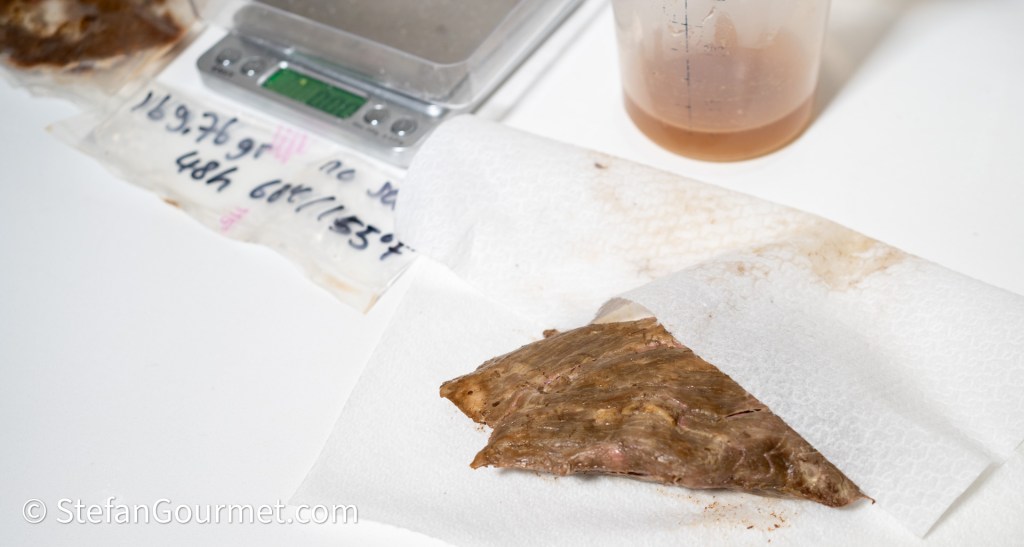
To determine the amount of juice lost during the cooking process, I weigh the meat with accurate scales before and after cooking. After cooking I take the meat out of the bag and dry it with paper towels before weighing.

The difference in weight as a percentage of the original weight, tells us the amount of juice from the meat that was lost during the cooking process. In the photo this is (138.73-101.15)/138.73 = 27%. When that number is lower, more juices have remained inside the meat, so the meat is more juicy. I weigh the meat before and after instead of measuring the amount of juices in the bag, because that is more accurate.
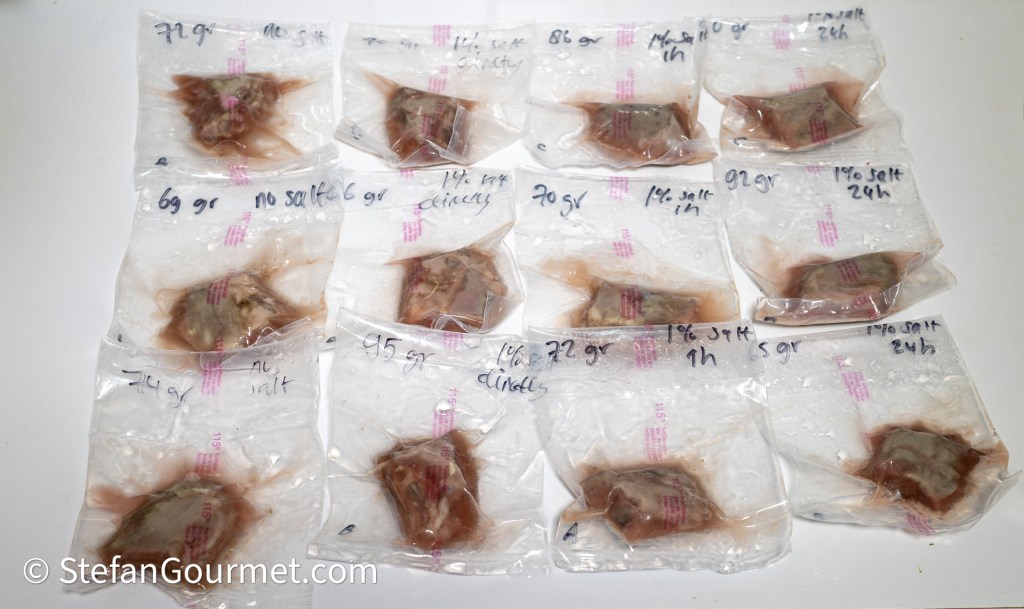
Over the years, I’ve done about 100 of those experiments with different types and cuts of meat like chicken, beef, pork, lamb, and even duck. Some examples are this post and this post. They’ve all had the same result: meat that is salted before sous vide, will end up more juicy than meat that goes in without salt!
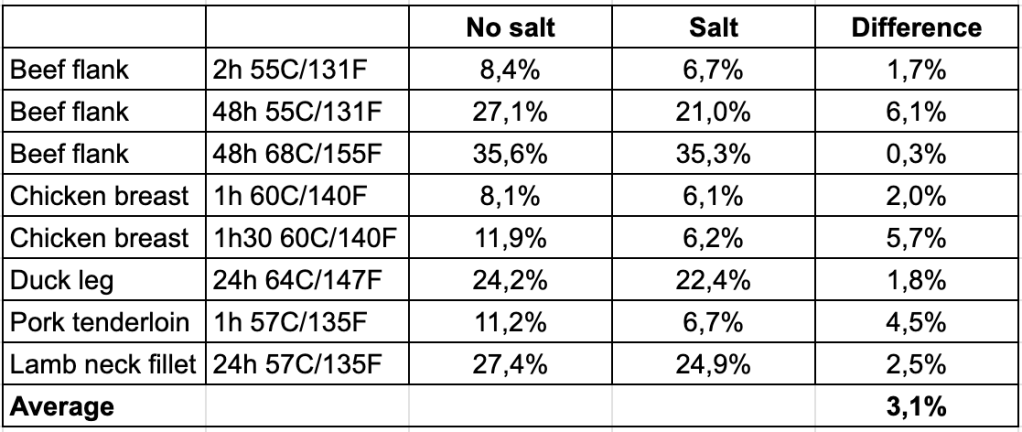
The average amount of juices that is saved by adding salt is 3% of the original weight of the meat. So for example if you start with a steak of 6 ounces or 170 grams, if you salt it before sous vide, you will save about a teaspoon of juice inside the steak. That is not a huge difference and you may not be able to clearly taste it, but it certainly demonstrates that salting before sous vide will not dry out the meat, and in fact has the opposite effect.
So how is this possible? It is true that salt draws out liquid, but then the salt dissolves into that liquid, and you are basically brining the meat inside the plastic bag. Some of that salty liquid will be absorbed back into the meat. If you wait long enough, the salt will penetrate all the way to the core of the meat. This is simply a matter of diffusion, and it will continue until the concentration of salt is the same everywhere in the bag, inside and outside of the meat. The time this will take depends on the thickness of the meat. By the way, when we say salt diffuses into the meat, we actually mean the sodium and chloride ions that salt consists of. They are so small that they can actually diffuse into the meat, unlike bigger molecules that can only flavor the outside.
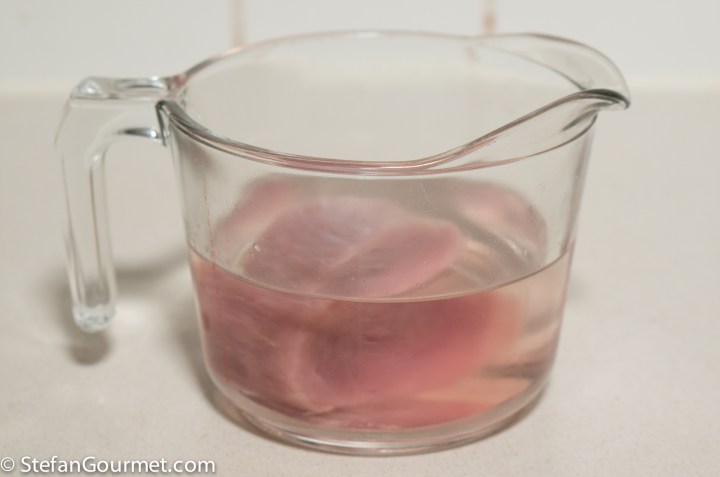
If you are familiar with brining meat before cooking it, this will probably not come as a surprise to you. Many people use a wet brine, which is water with salt and often sugar dissolved into it, and then soak the meat in this brine. This will cause the muscle fibers in the meat to swell and absorb water, as well as to better retain water when cooked. However, in my experiments I have found that most of the brine will be released again when you cook the meat. So in the end the result will be more or less the same as just putting salt on the meat and vacuum sealing it. Which is easier than having to prepare a brine and it is also more practical to have a sealed bag with meat in your refrigerator compared to a container with liquid. You can read more about this in this post. Salting before or after sous vide is not just about reserving meat juices, and the same goes for brining. If you salt before sous vide, the salty flavor will be inside the meat and not just on the outside. It enhances the natural flavor of the meat. The salt inside the meat will also affect the texture and will make the meat more tender.
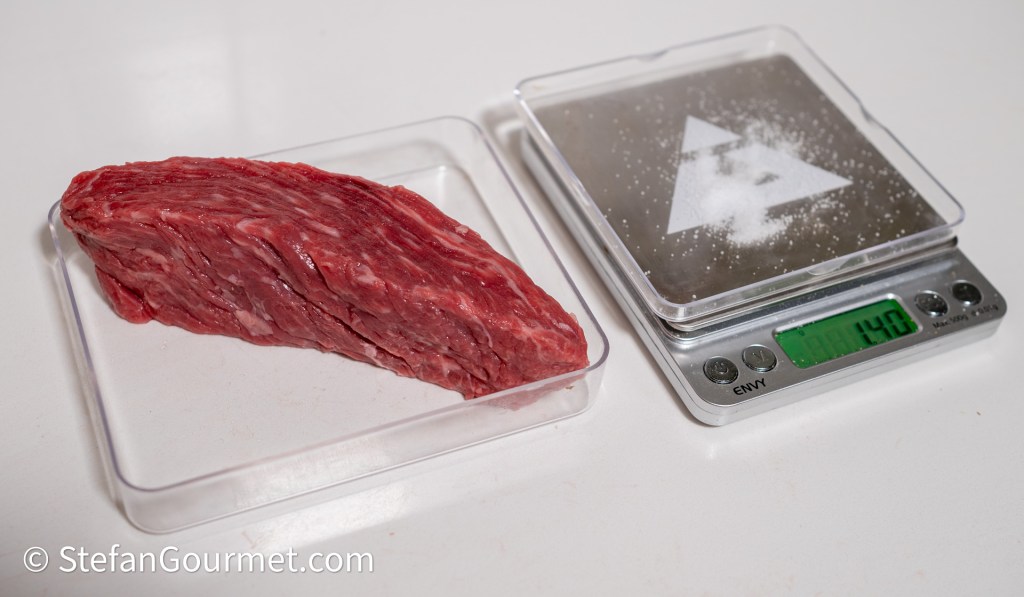
So how much salt should you put on the meat before vacuum sealing it? This is of course a matter of personal preference. I like to use about 1% salt of the weight of the meat. To make the meat more juicy and enhance its flavor even more, you could add more salt, and then add some sugar as well. The sugar will mask the salted flavor, so the meat will not taste as salty. A typical amount would be about 40% of the amount of salt. Personally I don’t like to do this. The flavor will be stronger, but less typical. Everything will start tasting the same if you use too much salt and sugar. If you use more than 2% of salt by weight, you will cure the meat and it will start to taste like ham. So I mostly stick with 1% salt.

Salting before sous vide is especially important when cooking fish sous vide. Fish is a very delicate protein that is very easily overcooked. Sous vide is a great way to avoid that. When cooking fish sous vide, my experiments have demonstrated that salting the fish at least half an hour before cooking greatly improves the texture. It will be more firm but tender, rather than mushy and watery. You can read more about that in this post. And this brings me to the topic of time. If you salt the meat before vacuum sealing, the salt will diffuse into the meat regardless of whether you let it rest first or cook it sous vide straight away. However, my experiments with fish have shown that it does make a difference whether the salt has already diffused into the meat when the cooking process begins, or diffuses into the meat during the cooking process.

When I was doing experiments with the combination of sous vide and freezing for this post, I had an unexpected result. Freezing first and then cooking sous vide resulted in a slightly lower loss of juices (6.0%) than just cooking sous vide without freezing first (6.5%), while one would expect that freezing would cause additional loss of juices. That difference became even larger when I defrosted the frozen raw chicken breast before cooking sous vide (4.8%). After giving it some thought, I suspected this was caused by the salt. During the freezing (and defrosting) of the raw chicken, the salt has more time to penetrate into the meat before the cooking begins and I suspected that may cause the differences.
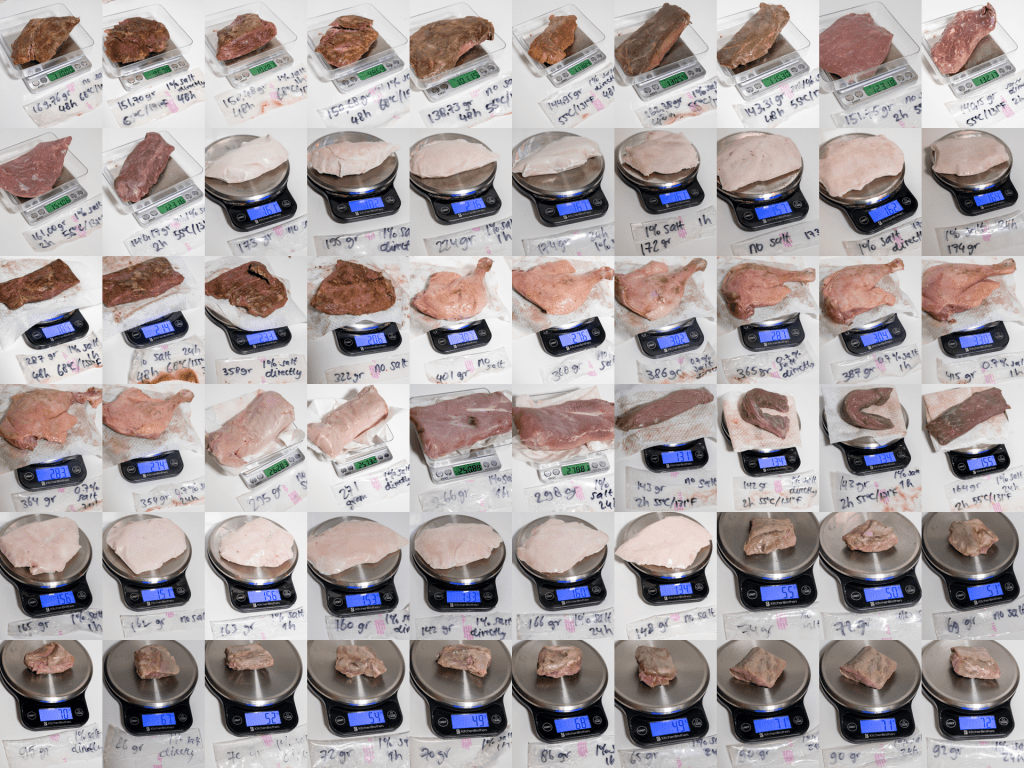
So then I did a lot of experiments where I cooked meat sous vide right away after salting and vacuum sealing it and compared that to allowing the salt 1 hour or 24 hours to penetrate into the meat before cooking. I did this with meats requiring a short cooking time such as chicken breast, but also with cooking times of 24 or even 48 hours. Most of the experiments were with lower cooking temperatures.

I am not saying these were scientific experiments. The pieces of meat used for the experiments were not exactly the same. For example, they my differ in size or shape, or they could contain a sinew that would contract the meat when it is heated, and thus squeeze out more liquid. The the way I salted them was also not exactly the same. I did weigh the salt, but the distribution could be slightly different and some salt could be left on the cutting board from salting the other side. So when I repeated the experiments, the results I got were a few percentage points apart because of such factors, as you can see in the table above. The different rows for the same type of meat and time/temperature indicate that I did multiple batches with the same parameters to see how consistent the results were. I am a home cook and I don’t want to throw away food, so we were eating all of the experiments and that limited the amount of experiment I could do. And so although I did dozens of experiments, that was not enough to average out those random factors. The conclusion that meat that is salted before sous vide retains more juices was confirmed by all of the experiments. But the results for different times were not consistent enough to draw any firm conclusions. It does seem though that for a short sous vide cooking time, it is more important to rest the meat between salting and sous vide cooking, then for a long sous vide cooking time. Although for a char siu marinade pork, allowing it to marinate first did make a difference in this experiment.
So what is my advice based on all of this?
- Always salt your proteins before cooking sous vide.
- If you have the time, allow the salted vacuum sealed protein to rest before cooking sous vide, especially if the sous vide cooking time is going to be short. But it is not a big deal to cook it straight away if you don’t have the time to wait.
- For fish it is essential to let it rest for at least half an hour between salting and sous vide cooking.


I like to vacuum my steaks before freezing them. And don’t like to take them out to salt before soups vide. So I have been salting them after sous vide. After reading your post, I’m wondering…Have you ever salted steak, vacuumed packed it, freezed it, and have it sous vide-d when needed? How did it turn out? Or if you haven’t done it, do you think it’s something that can be done?
LikeLiked by 2 people
I’ve done that a lot, and with chicken I’ve even done some experiments that I’m sure carry over to steak. So I definitely recommend it. https://natural-grow.today/2021/08/06/combing-sous-vide-and-freezing/%3C/a%3E%3C/p%3E
LikeLiked by 1 person
Wow, that is quite an extensive experiment! Interesting results too.
LikeLiked by 2 people
Wow you definitely invested some time into this! Thanks for sharing the extensive results. I’m a big fan of brining so it makes sense to me about salting prior to sous vide, however it never occurred to me to salt fish prior to sous vide cooking. I’ve got a nice salmon filet in the freezer and I’m going to give your technique a try. As always, I really enjoy your cooking and restaurant/wine reviews. I have learned a lot!
LikeLiked by 2 people
Thanks, that is great to read!
LikeLiked by 1 person
Thank you, this is a scientific post. Very interesting
LikeLiked by 2 people
Wow, that blog post was a very interesting read. Thanks for sharing these insights 🙏
I was very surprised to read that salting the meat before cooking it sous-vide makes it more juicy. Thanks for the detailed explanation 🙏
LikeLiked by 2 people